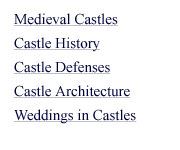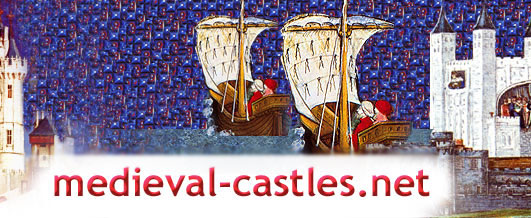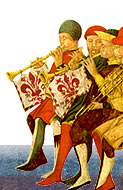Castle Defenses
The Attacking Army
Medieval castles often faced a variety
of threats from attacking armies, and Middle Age architecture
was always pushed to adapt new technologies to better defend
the walls. The popular vision of medieval battles on open
battlefields, complete with horses charging and banners flying
were more the exception than the rule. It took large numbers
of soldiers to storm a castle, so rather the attackers would
besiege a castle in hopes of starving out its inhabitants.
The attackers would not have to waste men and ammunition in
vain fights against thick castle walls. Attacking armies used
the following medieval weapons when trying to take a Middle
Age castle by force.
Siege Engines, Medieval "engines"
were often constructed by engineers who traveled with attacking
armies. These heavy weapons used simple physics of tensions
and torsion to launch stones, massive arrows, fire, and other
projectiles at the castle walls and into the bailey. Castles
returned fire with their own engines, but limited ammunition
was sometimes a problem for the defending army.
Catapults are the most well-known
medieval siege engine, and these constructs hurled stones
and other missiles. Some projectiles weighed up to a hundred
pounds, and successive shots would be launched at the same
spot if possible. Blow after blow by heavy rocks could bring
down early stone walls, so heavier walls were incorporated
in castle architecture. Attacking armies might launch other
objects, like a dead, diseased cow over the walls to spread
sickness. This could often be a devastating psychological
blow to starving inhabitants of a besieged castle. They would
be further demoralized with rotten food thrown over castle
walls. Rather nasty projectiles included beehives, and balls
of human or animal excrement were launched to harass castle
armies. A fortress' wooden buildings could be burned by flammable
projectiles. Spies that had the misfortune to be discovered
might also find themselves flung over a castle wall as a message
to the other army.
Trebuchets improved on original
catapult designs and were used during later medieval years,
even after artillery and gunpowder became the most powerful
weapons. These machines would harness the potential energy
of the projectile's suspended weight and boasted a faster
rate-of-fire than earlier catapults.
Ballistas looked like very large
crossbows. This medieval weapon originated in Roman times
but was developed over the centuries to launch up to a half
dozen spear-sized arrows at a time into lines of soldiers
or over the castle walls.
Battering Rams were far more complex
than the simple chopped down tree. They were often protected
with hut-like coverings, tipped with iron or burning pitch,
and mounted on wheels. Defending castle armies used Counter
Rams, a device dropped onto the attacking battering ram to
avoid repetitive blows at the same spot.
Mobile Assault Towers, sometimes
known as cats, could be assembled from components brought
to the site or harvested from the surrounding woods. These
towers gave an attacking army protection and high positions
to fire arrows when storming a castle. Some cats were even
built higher than a defending castle's towers to give attacking
archers an advantage.
|










